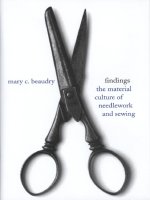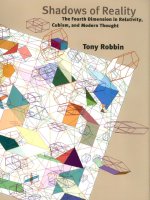yale university press findings the material culture of needlework and sewing jan 2007
Bạn đang xem bản rút gọn của tài liệu. Xem và tải ngay bản đầy đủ của tài liệu tại đây (1.07 MB, 252 trang )
Findings
Findings
The Material Culture of Needlework and Sewing
Mary C. Beaudry
Yale University Press
New Haven & London
Published with assistance from the foundation established in memory of
Philip Hamilton McMillan of the Class of 1894, Yale College
Copyright © 2006 by Yale University. All rights reserved. This book may not be
reproduced, in whole or in part, including illustrations, in any form (beyond that
copying permitted by Sections 107 and 108 of the U.S. Copyright Law and except by
reviewers for the public press), without written permission from the publishers
Set in Electra type by Tseng Information Systems, Inc. Printed in the
United States of America by Sheridan Books.
Library of Congress Cataloging-in-Publication Data
Beaudry, Mary Carolyn, 1950–
Findings : the material culture of needlework and sewing / Mary C. Beaudry.
p. cm.
Includes bibliographical references and index.
isbn-13: 978-0-300-11093-7 (clothbound : alk. paper)
isbn-10: 0-300-11093-6 (clothbound : alk. paper)
1. Pins and needles—History. 2. Sewing—Equipment and supplies—History.
3. Needlework—Equipment and supplies—History. I. Title.
a gt2280 .b43 2006
306.4—dc22 2006015214
A catalogue record for this book is available from the British Library
The paper in this book meets the guidelines for permanence and durability
of the Committee on Production Guidelines for Book Longevity of the
Council on Library Resources
10987654321
In memory of my mother,
Mary Mason Barkuloo Beaudry,
who continued to take joy in her sewing despite losing her sight
Acknowledgments ix
one Introduction: Small Finds, Big Histories 1
two The Lowly Pin 10
three The Needle: ‘‘An Important Little Article’’ 44
four The Ubiquitous and Occasionally Ordinary Thimble 86
five Shears and Scissors 115
six Findings: Notions, Accessories, and
the Artifacts of Textile Production 137
seven Stitching Together the Evidence 169
Notes 179
References 207
Index 227
vii
I owe great thanks to many people for their assistance and supportiveness over
theyearsasIhaveworkedinmyhaltingfashiononthisbook.CarlCrossman’s
enthusiasm on finding a monogrammed silver thimble at my site, the Spencer-
Peirce-Little Farm in Newbury, Massachusetts, inspired me to research the arti-
facts of needlework and sewing, and I thank him for that as well as for all the
many volunteer hours he donated to the Spencer-Peirce-Little Project, enlight-
ening me and my students all the while about ceramics and material culture in
general. George Miller, Richard Candee, and Jane Nylander encouraged me to
pursue this project and were instrumental in my good fortune in securing a fel-
lowship to conduct research at the Winterthur Museum and Library.
As I embarked on my research, Jean Wilson, through the good offices of her
husband, Norman Hammond, told me to read Roszika Parker’s book The Sub-
versive Stitch. Parker’s insightful book helped frame my thinking, and I am ex-
ceedingly grateful to Jean for putting me on to it in my early research.
I am also grateful to have been blessed twice, in 1994–95 and in 2001, with the
opportunity to pursue research at the Winterthur Museum and Library, in both
instances funded by a National Endowment for the Humanities Fellowship for
Advanced Study. Winterthur is, of course, a mecca for material culture research-
ers, and it is not just the library and its marvelous resources that make working
there so special. Neville Thompson, now retired, was librarian during both of my
fellowship periods; she was a marvel at recommending relevant resources in the
Winterthur collection and in suggesting avenues I might pursue in winkling out
the sorts of information I was after. She has been called ‘‘Librarian Extraordi-
naire’’ with good reason! I also thank E. Richard McKinstry, Andrew W. Mellon
Senior Librarian, for his help with archival materials; Linda Eaton, Curator of
Textiles, for her generosity with her time and expertise; Gary Kulik, Director of
ix
x Acknowledgments
Library Operations, and J.Ritchie Garrison,Director ofthe Winterthur Program
in Early American Culture, for their guidance; Gretchen Buggeln for her cheer-
ful support and assistance; Bert Denker for help with photography and photo-
graphic resources; Sue Newton and Dot Wiggins for assisting me with securing
illustrations of Winterthur materials; and Pat Eliot for being the best.
One of the delights of the Winterthur experience is the opportunity to in-
teract with other visiting scholars, and I enjoyed the many conversations with
other Winterthur researchers Bernard Cotton, Tom Denenberg, Terence Lock-
ett, Carl Lounsbury, Joe Torre, and Shirley Wadja.
In 1995 I was able to continue my research in England while I was a Visit-
ing Professor at the Department of Archaeology and Prehistory at the University
of Sheffield, and I thank then Head of Department, Keith Brannigan, and then
Head of the Research School, Barbara Ottaway, for hosting me so graciously,
providing office space, and including me so thoroughly in department activities.
James Symonds, Director of the Archaeological Research Consultancy at the
University of Sheffield (ARCUS), took me under his wing, as it were, befriended
me, and assisted meininnumerable ways. Amonghismany kindnesses was intro-
ducing me to John Widdowson, Director of the Centre for Folklife Studies at the
University of Sheffield, who gave me access to the research library of the Cen-
tre, where I found many useful sources. I am also grateful to David Crossley for
permitting me to sit in on his lectures and tag along on field trips; David and
his wife, Elizabeth, also took me to many local sites of interest, among which for
me the most impressive was Hardwick Hall in Derbyshire, with its outstanding
collection of sixteenth- and seventeenth-century embroideries.
Dr. Vince Gaffney, former Director of the Forge Mill Needle Museum, Red-
ditch, and Jo Ann Gloger, its current Director, were most welcoming and help-
ful, allowing me to explore the museum and its archives, with its rich collection
of documents pertaining to the needle industry.
In1995Ialso had theprivilegeof being aVisitingScholar at the Philips Library
of the Peabody Essex Museum in Salem, Massachusetts. There I was able to
read many account books and women’s diaries and to conduct research in Essex
County records, and I am grateful to William LaMoy, Jane Ward, and John Koza
for their patient guidance and insight into the collections, and Daniel Finamore
for his collegiality and many kindnesses. The highlight of my time at the Pea-
body Essex was the opportunity to explore with Curator Paula Richter the col-
lections in storage, most of which have not just Essex County provenance but
well-documented histories in local families. And, of course it is always a thrill
for an archaeologist to be able to see and touch (indirectly, with gloved hands)
items of the sort she will never recover from the earth.
Acknowledgments xi
Many archaeological colleagues generously allowed me access to their col-
lections. Henry Miller and Silas Hurry of Historic St. Mary’s City, Maryland,
opened the St. Mary’s City collections for my inspection, and Silas has served
as a sounding board and font of useful information over the years. Julia King,
Director of the Maryland Archaeological Conservation Laboratory at the Jeffer-
son Patterson Park and Museum in Lexington Park, Maryland, allowed me ac-
cess to materials from all of the seventeenth-century domestic sites held by her
museum and Dan Mouer and Robin Ryder let me roam freely through the col-
lections held by the now-defunct Archaeological Research Center at Virginia
Commonwealth University in Richmond, Virginia. Charles Burke and Andrée
Crépeau paved the way for me to examine the spectacular collection of sewing
artifacts recovered from Fortress Louisbourg in Nova Scotia. I must apologize in
advance that they will find that I did not incorporate any of the Louisbourg ma-
terial into this work and plead what I fear is a lame excuse: the data mysteriously
disappeared from my computer before I could back it up.
Other colleagues sent orloaned me materials that have provedhelpful, among
them Sharla Azzizi, Edward Bell, Ellen Berkland, Kelly Britt, Eleanor Conlin
Casella, Edward Chaney, Joyce Clements, Sara Rivers Cofield, Linda Derry,
Diana DiPaolo Loren, Wilhelmina Lunt, Marla Miller, Stephen Mills, Virginia
Myles, Martha Pinello, Peter Pope, Mary Praetzellis, Marta Cotterell Raffel,
Suzanne Spencer-Wood, Roderick Sprague, Kathleen Wheeler, Carolyn White,
Rebecca Yamin, and Anne Yentsch.Forassistance with securing illustrations and
permissions to reproduce them, I thank Sara Rivers Cofield, Lorna Condon,
Sally Hinkel, Ann-Eliza H. Lewis, Douglas Lister, Rebecca Morehouse, Sharon
Raftery, and Howard Wellman.
I am grateful to Lara Heimert for making it possible for me to publish with
Yale University Press and to Christopher Rogers, Executive Editor, and Ellie
Goldberg, Assistant Editor, for making working with Yale such a pleasant ex-
perience. Laura Jones Dooley, Senior Satellite Editor for Yale, did a wonderful
job copyediting the manuscript, turning my stilted prose into readable English.
Heartfelt thanks to Karen Bescherer Metheny and Ann-Eliza H. Lewis for help-
ing me so much by applying their sharp eyes and sharp minds to the task of
proofreading.
Throughout my research and writing, Lu Ann De Cunzo, Julie King, and
Rebecca Yamin have been unfailingly supportive and always helpful with ideas
about how I should approach my research and writing. I value their friendship
and have been inspired by the writings that they have produced while I slowly,
slowly stitched away at this ‘‘bit of work.’’
Introduction
Small Finds, Big Histories
My interest in the material culture of needlework and sewing began in the
early 1990s, with the slowly dawning realization that many items I was finding at
the Spencer-Peirce-Little Farm in Newbury, Massachusetts, the site I had been
excavatingsince1986, were artifacts related to sewing. Each season we foundone
or more thimbles and many straight pins; every so often we recovered a pair of
sewing scissors. The 1993 season turned up several objects we could not identify
at first, among them a carved bone bobbin that, I later learned, was used to make
lace. That year we also found a silver thimble with a monogram. It occurred to
me that such a valued personal object could serve as the point of entry for learn-
ing about the women who once lived at this site, women about whom both the
documentary and archaeological records thus far have been disappointingly un-
informative.
1
Although I had watched my mother sew and had learned embroidery when
young, I was a spectacular failure in the sewing portion of the home economics
course I was required to take in high school. Not being inclined to pursue ac-
tivities that I am not good at, I have since avoided sewing anything. And so my
understanding of sewing and its associated paraphernalia was rudimentary, even
though I often excavated sites at which generations of women had spent much
of their lives sewing, mending, making lace, and the like. Their pursuits were
largely invisible to me because I did not recognize the implements used in such
work for what they were. Like most of us, I knew a pin or a needle or a thimble—
and certainly a pair of scissors—when I saw one, or even part of one. But there
my knowledge ended. I could only guess at the identification of other objects,
especially if they were not part of the great trinity of historical archaeologists’ arti-
facts: ceramics, clay pipes, and glass.
Excavated artifacts of needlework and sewing—pins, needles, thimbles, and
1
2 Introduction
so on—fit quite naturally, albeit often anonymously, into the category of ‘‘small
finds.’’Although thephrase ismore likelyto be usedbyexcavatorsworking within
the British archaeological idiom than by American historical archaeologists, a
state of mind pervades the field as a whole that has led to acceptance of a narrow
set of conventions in thinking and writing about small finds.
Historical archaeologists tend to assume, without giving it much thought, that
ceramics, glass, clay pipes, and animal bones are more informative and hence
of far greater interest than many other sorts of finds, and they have developed
useful and widely employed conventions for presenting, analyzing, and inter-
preting those categories of material. Yet even though historical archaeology has
burgeoned over the past four decades and is now practiced all over the globe,
huge gaps remain in our knowledge of the material culture of medieval, early
modern, and modern times. The frequent reprinting of Ivor Noël Hume’s Guide
to Artifacts of Colonial America, the appearance of Kathleen Deagan’s two vol-
umes devoted to artifacts of the Spanish colonies, and the publication in 2000
by the Society for Historical Archaeology of a volume of artifact studies and of a
second edition of a collection of artifact studies reprinted from its journal, His-
torical Archaeology, are ample proof that we hunger for more information about
the artifacts we dig up.
2
The increased interest in gender analysis among historical archaeologists has
given rise to greater interest in objects that might be related to women and, espe-
cially, to women’s activities. This has led since the early 1990s to attempts to fill
the gaps and remedy the silences of findsanalysis by seeking out objects that have
not been studied because they were deemed trivial for the very reason that they
were associated with women’s domestic activities. Because sewing is so univer-
sally associated with women, artifacts of needlework and sewing often stand as
evidence of women and women’s activities. The link is based in part on reality
but also on uncritical assumptions about sewing and how sewing ties in with the
lives of both men and women.
Throughout history, activities customarily performed either by men or by
women have become associated with and deemed appropriate to members of
one sex or the other. Through such customary associations various undertakings
and responsibilities have become culturally designated as the ‘‘natural’’ province
of one sex or another and therefore integral to the definition of gender identity
through designation of gender roles. The processes, settings, tools, and materials
employed in an enterprise are metonymically transformed into symbols of sex-
specific tasks and so become emblems of gender identity (fig. 1.1).
3
Gender identitycan beconstructed andnegotiated(asopposed tobeingsimply
Fig. 1.1 Frontispiece for Easy Steps in Sewing for Big and Little Girls, published by
Jane Eayre Fryer in 1913. The girl’s sewing tools have come to life to keep her company
during what would otherwise be tedious hours in the sewing room as she is instructed
in sewing and femininity by another animated friend, her little sewing bird.
(Courtesy The Winterthur Library: Printed Book and Periodical Collection)
[To view this image, refer to
the print version of this title.]
4 Introduction
assigned). Archaeologist Barbara Luedtke wrote that it is important to attend to
the possibility, if not likelihood, that ‘‘the meaning of our archaeological arti-
facts variedwithcontext.’’InthisbookIexplore,throughtheexampleofthe
artifacts of needlework and sewing, ways in which gender identity can be sig-
naled and can shift according to context. These issues can be examined by re-
constructing, through critical analysis of documentary and pictorial sources, the
ethnographic contexts in which sewing and needlework served practical ends
and those in which sewing and needlework implements featured as symbols in
myth or ritual or as expressions of sentiment in society; by examining the classi-
ficatory logic underpinning the ‘‘gendered’’ nature of sewing; and by close read-
ings of instances in which the ‘‘usual’’ symbolic import of sewing implements is
subverted through symbolic inversion and anomaly.
4
Feminist art historian Rozsika Parker, in her groundbreaking work The Sub-
versive Stitch, examines how ‘‘embroidery has become indelibly associated with
stereotypes of femininity’’—femininity being a ‘‘crucial aspect of patriarchal
ideology.’’ She demonstrates through detailed analysis of works—written and
stitched—by both men and women that ‘‘the development of an ideology of
femininity coincided historically with the emergence of a clearly defined separa-
tion of art and craft.’’ The division began during the Renaissance, at a time when
embroidery was done more and more by women working in the home rather
than by professional, usually male, embroiderers. During the seventeenth cen-
tury, embroidery was used to inculcate femininity in young girls, so much so that
‘‘the ensuing behaviour appeared innate.’’ An ideology of femininity as natural
to women evolved in the eighteenth century, and from the eighteenth century
on, embroidery came to signify femininity as well as a leisured, aristocratic life-
style, proof of gentility because of its association with nobility,
providing concrete evidence that a man was able to support a leisured woman.
Moreover, because embroidery was supposed to signify femininity—docility,
obedience, love of home, and a life without work—it showed the embroiderer
to be a deserving, worthy wife and mother. Thus the art played a crucial part
in maintaining the class position of the household, displaying the value of a
man’s wife and the condition of his economic circumstances. Finally, in the
nineteenth century,embroidery and femininity werefused and theconnection
was deemed to be natural. Women embroidered because they were naturally
feminine and were feminine because they naturally embroidered.
5
But, Parker notes, though many women may have ‘‘colluded’’ in the continuance
of this construction of gender identity, they were not always passive recipients of
such ideologies but responded to them: women used these ideologies and were
Introduction 5
used by them. Over the centuries, embroidery has provided support and satisfac-
tion for women and has served as a covert means of negotiating the constraints of
femininity; women were able to make meanings of their own while overtly living
up to the oppressive stereotype of the passive, silent, vain, and frivolous, even
seductive needlewoman. Parker’s eye-opening study provides the framework for
my examination of the material culture of fancy needlework alongside the arti-
facts of ordinary sewing.
6
Consider for a moment the likelihood that complex civilizations could have
arisen if no one had invented cordage for tying up bundles, creating strings from
fibers that could be manipulated in many ways, knotted, netted, laced through
skins, woven into cloth. If women had never experimented with fibers, if this ex-
perimentation had never led to textile production, to clothing, tapestries, blan-
kets, bags, coverings of all sorts, the course of civilization, if indeed there was any,
would be unimaginable, unthinkable. Textile production and sewing of some
sort have been tangled up with aspects of culture—technological, social, eco-
nomic, ritual, and so on—since early in human history. As a result, the products
of weaving and needlework, the tools used in these processes, and the persons
who undertook these activities were enmeshed in a system of symbols with mul-
tiple meanings. The job of the archaeologist, as I see it, is to investigate the cul-
tural complex of sewing in order to explore how needlework implements carried
meaning in specific historical and cultural contexts and then to place these care-
fully constructed cases into wider cultural contexts.
7
Needlework held both homey and utilitarian as well as broader social conse-
quence.Spinning,sewing, mendingandremakinggarments, andmarkingsheets,
towels, and other linens was a regular component of household work done or
overseen by women. Genteel women and girls engaged in fancy or decorative
needlework as testimony to their skill in the feminine arts as well as to a so-
cial position that permitted leisure for such nonutilitarian pursuits. At the same
time, not all fancy needlework was a pastime for wealthy women of leisure, nor
was all utilitarian sewing destined for immediate household use. Many a needle-
woman depended on the income her handiwork could generate. Knowing this,
it is clear that the artifacts of needlework from historical sites can be interpreted
along several lines of social and economic relevance: everyday, ‘‘practical’’ or
‘‘necessary’’ work (sewing, mending, and knitting); ‘‘fancy work’’ (embroidered
pictures, muslin or ‘‘whitework,’’ cutwork, candlewicking, tambour work, stuffed
work, canvas work, and so on); and work of either sort produced for sale outside
the home. Attention to the type, quality, and intended functions of the artifacts
of needlework and sewing makes it possible to address the issues of the nature or
quality of sewing activity and to relate this to household income and manage-
6 Introduction
Fig. 1.2 A needlework picture stitched by Jane Peirce of Newbury, Massachusetts, in
1734, when she was five years old. (Courtesy New Hampshire Historical Society)
ment strategies, to social standing and social display, and to the construction of
gender identity.
8
In the collections of the Historical Society of New Hampshire there survives
a wonderful embroidered picture (fig. 1.2). It was done in 1734 by Jane Peirce
when she was five years old. Jane was one of seven children of Charles Peirce and
Sarah Frost, and she grew up in the Spencer-Peirce-Little House, on the farm
[To view this image, refer to
the print version of this title.]
Introduction 7
where I have spent so many seasons excavating. The embroidered picture is a
rare and marvelous survival, tangible evidence of needlework in service to the in-
culcation of and construction of feminine identity. In the chapters that follow I
explore ways of identifying and interpreting the needlework tools archaeologists
commonly find; in my case, I am hoping that the knowledge I have accumu-
lated will help me understand the sewing implements excavated from the soils
around the house where young Jane stitched her canvaswork picture and to re-
construct a more complete picture of the generations of women who plied their
needles at the Spencer-Peirce-Little Farm. But I am hopeful that the guidelines
I provide will prove useful for other archaeologists, and I have sought out many
additional case studies beyond my own site to provide examples of how differing
contexts lead to differing interpretations.
9
My approach is broadly interpretive, and my aim is to move past the ostensibly
simple first steps of artifact identification and dating and even beyond ‘‘engen-
dering’’ artifacts by bringing multiple lines of evidence to bear on the interpre-
tation of the material culture of sewing and needlework in the ‘‘active voice.’’ An
interpretive approach acknowledges that material culture is not just something
people create but an integral component of our personalities and our social lives,
deeply implicated in how we construct social relationships. Trying to compre-
hend what things meant to people in the past is not the most easily undertaken
task, but it is not altogether impossible, especially not for historical archaeolo-
gists. My goal is to construct a rich contextual analysis of how women and men
used objects of needlework and sewing and to consider the multiplicity of mean-
ings these everyday items conveyed. Sometimes the best way to do this is to try
to reconstruct the stories in which people and their things played active roles, to
construct narratives that ground interpretation in the everyday lives of people in
the past and in the life histories of the objects that archaeologists find otherwise
mute or mysterious and strangely distant.
10
I see the analysis of documentary evidence as vital to constructing the inter-
pretive ground, as it were, for artifact analysis. This is why, throughout this book,
I offer case studies that track back and forth among documents and artifacts to
offer interpretations that arise from the combined evidentiary sources. Alison
Wylie has described this process as one of constructing cables of inference; her
metaphor is a powerful one and aptly captures what I am attempting to accom-
plish.
11
An important step in the research process involves casting a wide net through
primary and secondary sources to learn generally about the importance of
needlework in women’s (and men’s) lives. This involves knowing what articles
different needlework tools were used to produce and their social, cultural, and
8 Introduction
economic significance, the contexts of production, and the social implications
of different forms of needlework. It is clear that cloth production, sewing, and
needlework played an important part in the lives of most women throughout his-
tory and that the implements of these activities, because they were associated
with women, often served as symbols of women’s status and women’s role.
12
Consider the seemingly most obvious and most trivial of all small finds—the
common straight pin and the not-so-logical syllogism about pins that one often
encounters in the literature. Pins equal sewing, or so most archaeologists assume;
they also assume that sewing was done by women. Therefore, pins = sewing =
women. But, as I explore in chapter 2, common straight pins were used to fas-
ten both men’s and women’s clothing, to fasten documents, to fasten shrouds, to
serve as guides for thread in lace-making, to conjure spells and to ward against
them; in other words, pins were used for many purposes beyond sewing. And it is
sometimes possible to differentiate what these purposes might have been, since
pins were made in varied sizes because different sizes were needed for the diverse
purposes I’ve mentioned. But because we think we ‘‘know’’ what pins mean, we
do not pay them much attention. A typical illustration in an archaeological re-
port will show a small pile of pins from various contexts at a given site carefully
set beside the other items the archaeologists assume are women’s things or part
of the sewing assemblage.
In the following chapters, I examine items of the material culture of needle-
work and sewing that are most likely to survive in archaeological contexts: pins
(chapter 2); needles (chapter 3); thimbles (chapter 4); scissors (chapter 5); and
less common items associated with weaving, lace-making, and the finishing of
garments (chapter 6).I focus onimplements ortools;Ido not considertextiles ex-
ceptasthey relate to sewing, and Ido notconsider buttons because although they
are sewn onto clothing and usually serve as fasteners, in my mind they are not
tools of needlework but functional clothing fasteners, items of personal adorn-
ment,orboth.
13
In each chapter I present the history of the type of implement under consider-
ation as well as a comprehensive discussion of the techniques of manufacture
and, where relevant, conditions under which the objects were produced. I think
it is important to understand how changing technology brought about changes
in form and functionality of objects, and like many before me, I am intrigued by
the nature of the work involved in the production of items like pins and needles
as well as the conditions under which youngsters, men, and women labored to
produce practical and fancy items used in sewing or worn as elements of social
display. I have also attempted to present for each type of artifact a comprehensive
guide to dating as well as identifying excavated specimens and suggestions for in-
Introduction 9
terpreting their intended uses. My intent is to provide archaeologists with better
ways of making fine-grained distinctions within seemingly homogenous cate-
gories of artifacts, as well as to provide for historians and collectors of needlework
tools information about what sorts of things archaeologists have recovered. My
primary goal, however, is to provide examples of ways to construct contexts for
interpretation of needlework tools. To this end, I conclude each artifact-specific
chapter with a case study that suggests possible avenues of interpretation. In the
concluding chapter, I attempt to ‘‘stitch together the evidence’’ by turning to a
wider consideration of the significance of sewing and needlework in the lives of
men and women, looking at sewing as a profession and as a pastime, and offer-
ing final thoughts on how archaeologists can use the excavated material culture
of needlework and sewing to illuminate ways in which the people who lived and
worked at the sites they excavate incorporated such items into their daily nego-
tiations of personal and social identity.
2
The Lowly Pin
He that will not stoop for a pin will never be worth a pound.
—samuel pepys, Diary, 2 January 1668
Common straight pins made of copper-alloy wire are recovered in impressive
numbers from almost all domestic sites of the medieval, early modern, and mod-
ern eras. What could seem more ordinary and trivial than a common pin (fig.
2.1)? This, at least, is the attitude most archaeologists take. When they excavate
straight pins, unless the pins are unusually long or have decorated heads or are
otherwise distinctive, archaeologists assume that all are sewing pins and tend to
lump the pins together as such without regard for where they came from on the
site and for what other objects they were associated with in the ground. And ar-
chaeologists tacitly assume that if the pins are for sewing they must have been
used by women. Hence the common straight pin has become, in the archaeo-
logical literature at least, a widely accepted indicator for the presence of women.
Butthesituation is far morecomplicated than thissimplistic equation permits.
Pins were indeed used for sewing, by both men and women (although accom-
plished tailors and professional seamstresses used few if any pins in their work),
but they served many other functions as well, and they were even perceived at
times as having magical or prophylactic powers against witches and other ma-
levolent forces.
1
THE HISTORY AND ARCHAEOLOGY
OF THE COMMON STRAIGHT PIN
Pins of various sorts are common finds on archaeological sites throughout the
world. Those found on historical sites are technologically superior though essen-
tially similar in shape and function to the individually fashioned, handmade pins
of prehistoric times. Since the very earliest of times pins have served as fasten-
10









